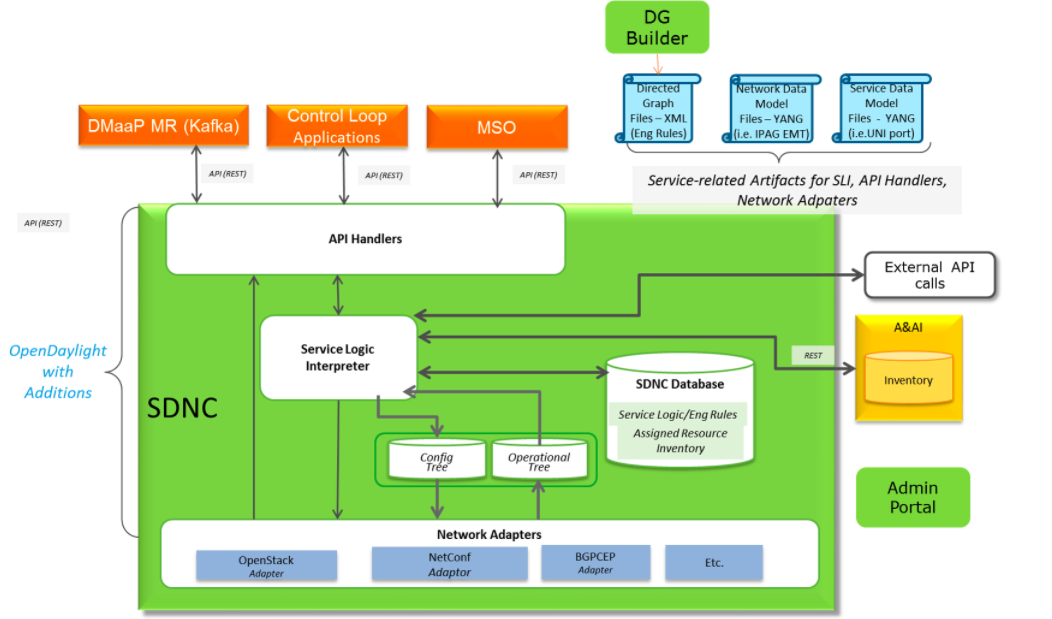A Controller manages the state of a single Resource (Application , Infrastructure, or Network). It executes the Resource's configuration and instantiation, and is the primary agent in ongoing management, such as control loop actions, migration, and scaling. All of these actions involve executing workflows (recipes) obtained from Service Design and Creation (SDC). In addition, the Controller reports the status of each workflow execution to both the Active and Available Inventory (AAI) and the Master Service Orchestrator (MSO).
In effect, each Controller instance supports a form of orchestration to manage the operations that are within its scope. This lowThis orchestration is a lower-level of orchestration than the orchestration is done outside by the MSO.
The MSO is responsible for ensuring that the Controller successfully completes its Resource configuration as defined by the workflow.
ONAP uses different OpenECOMP uses three distinct Controller types to manage Resources in the execution environment, corresponding to their assigned controlled domain:
- Cloud computing resources (Infrastructure Controller, typically within the cloud layer)
- Network configuration (Network Controller)
- Application (Application Controller).
Infrastructure Controllers
Infrastructure Controllers typically execute OpenStack requests for the creation of virtual machines (VMs), and load the Virtual Function (VF) software into the new VM container. To do this, the Infrastructure Controller obtains the Virtual Function's Resource workflow from the SDC. The Resource workflow will define VM sizing, including compute, storage, and memory. When the Infrastructure Controller completes the request, it will pass the virtual resource identifier and access (IP) information back to the MSO to provide to the Network and Application controllers.
If the Resource workflow requires multiple VMs, the MSO will repeat the process, requesting each Infrastructure Controller to spin up one or more VMs and load the appropriate VFs.
...
Both these controllers are based on an OpenDaylight Controller Framework.
Network Controllers
A Network Controller, such as SDNC, instantiates a Virtual Network Function , by carrying out its network configuration workflow and reporting the resulting status (to both AAI and MSO).
Application Controllers
Figure 1. SDNC Network Controller
<<TODO Find Reference and example DG and SLI extension node in a Gerrit Project>>
Application Controllers
Application controllers, such as APPC, receive orchestrated requests from the MSO, which obtains application-specific components and attributes from SDC. The Application Controllers will be requested by the MSO to obtain the application-specific component of the Service workflow from SDC and execute the orchestration workflow. The MSO continues to be responsible for ensuring that the Application Controller successfully completes its Resource configuration as defined by the workflow.
Note that not all changes in network or service behavior are the result of orchestration. For example, Application Virtual Functions can change network behavior by changing rules or policies associated with Controller activities. These policy changes can dynamically Policies and rules (in the Policy subsystem) inform the controller such that the Controller can enable service behavior changes.
OpenECOMP ONAP includes a generic Application Controller (APPC, formerly called APP-C) that receives commands from OpenECOMP ONAP components, such as MSO, DCAE, or the Portal, and uses these commands to manage the life cycle of Services, Resources (virtual applications and Virtual Network Functions), and their components. See the <<Application Controller The Application Controller is based on the same OpenDaylight Framework with SLI additions. The Application Controller project provides SLI node types, adapters, and API handling logic required for the life cycle management of complex, distributed services composed of many VNF types and instances.
Documentation:
- ONAP Application Controller User Guide
- APPC API Documentation
- APP-C Ansible Adapter Documentation
- APP-C Chef Adapter Documentation
NOTE: For instructions on how to build and run an ONAP Component (APP-C ) API Guide>>is taken as an example) locally, please refer to this documentation.
